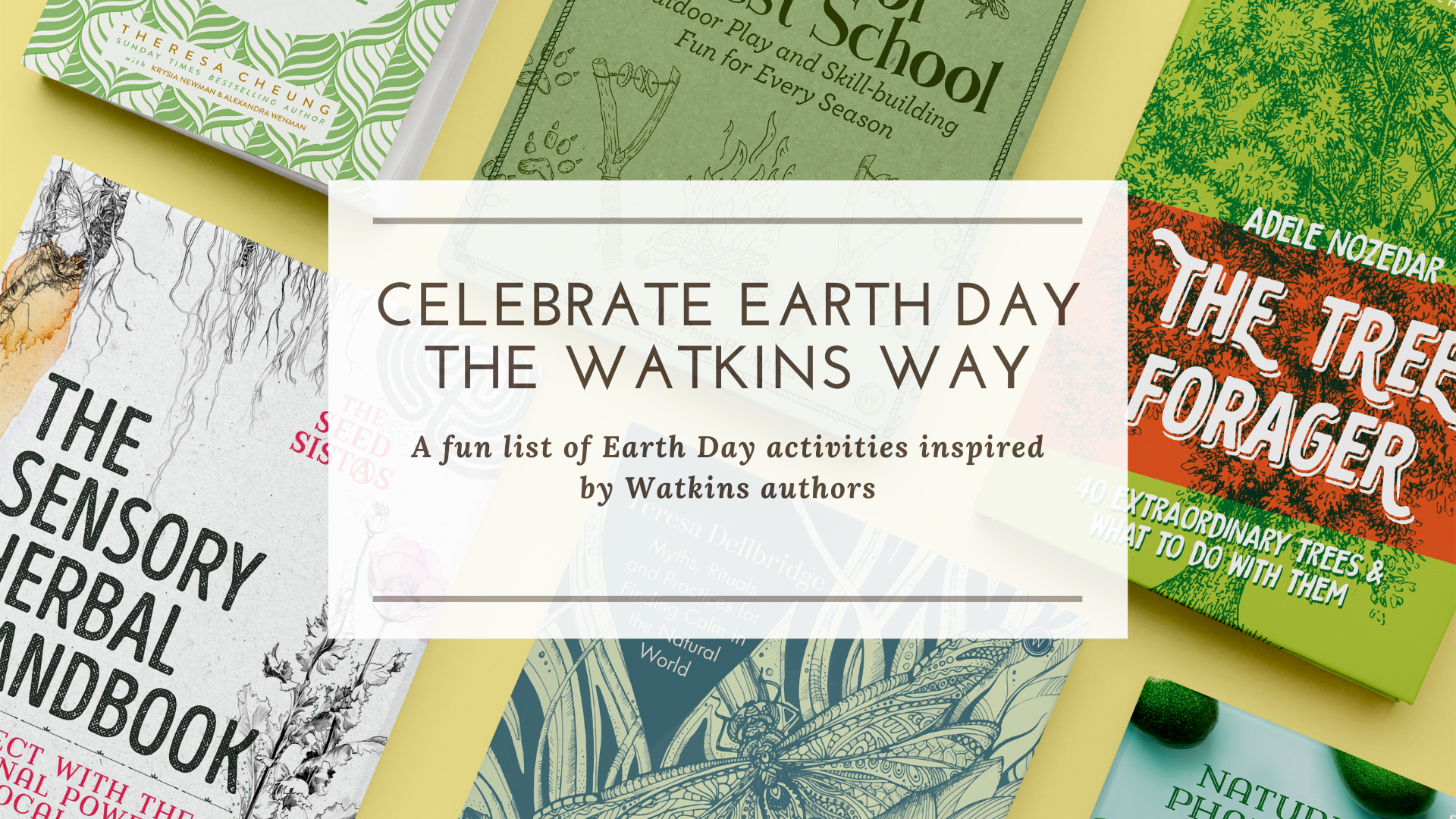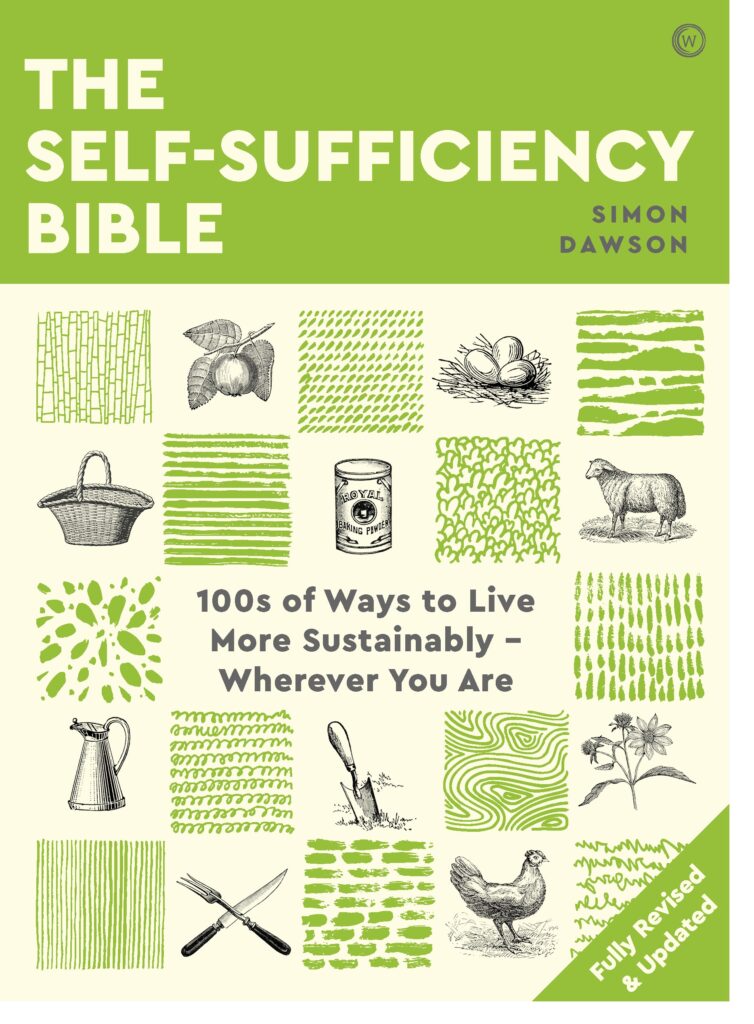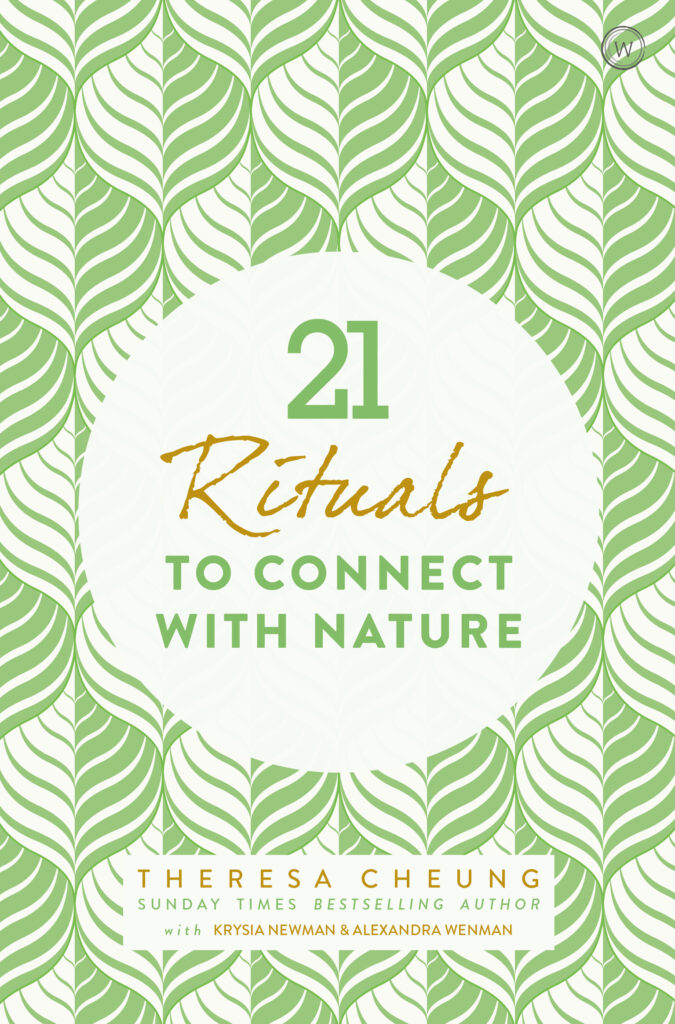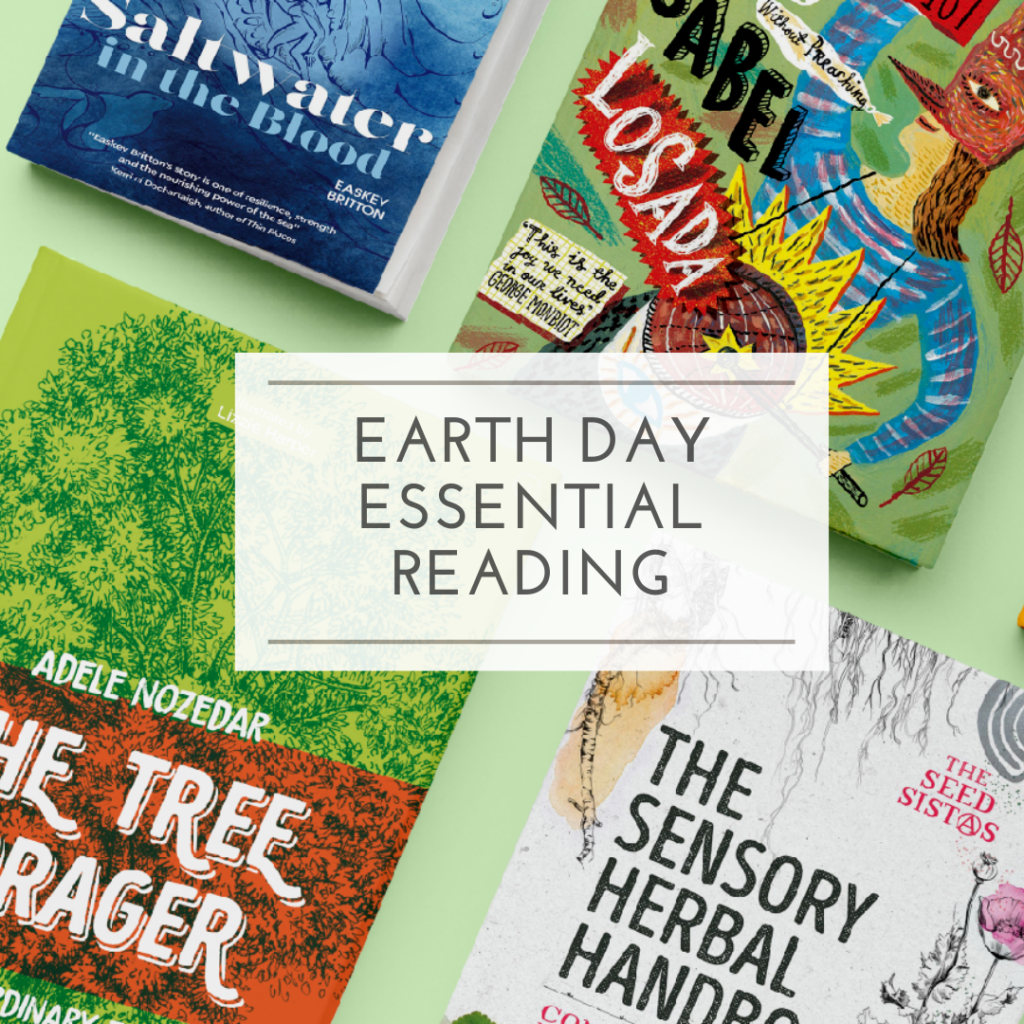Celebrate Earth Day the Watkins Way

In honour of Earth Day on 22nd April, we’re sharing some fun activities recommended by Watkins authors that can help you make a positive impact on the environment and reconnect with nature.
1. Make an Earth Day birthday cake from mud
Celebrating the Earth is a wonderful way to reconnect all of us to nature and, with a cake at centre stage, what could be more fun?
This is messy play for children at its best: a mud cake made from earth and water, decorated with nature’s gems – fallen petals, leaves, sticks and stones. Whatever the forest or garden floor provides to inspire the designer.
2. Make an Earth Day card or decorations with homemade paper
Making paper at home is all about recycling: taking old newspapers, old utility bills (nothing more satisfying than putting a bill into a blender and blitzing it) and turning them into crisp new sheets ready to be turned into your own greetings card.
EQUIPMENT
- Washing-up bowl
- Blender
- Deckle
- 2 tea towels
- Rolling pin
- Iron
INSTRUCTIONS
- Prepare the paper you are going to use by shredding it, ripping it into strips or tearing it into coin-size pieces
- Half-fill the bowl with warm water and soak the prepared paper for about 1 hour, then drain through a colander.
- Half-fill the blender with water, and add a little of the pulped paper, taking care not to add too much in one go as it will just clump. Blend it until it is completely smooth without any lumps, adding more pulp little by little.
- Meanwhile, rinse out the washing-up bowl and half-fill it again with warm water. Slide in your deckle so it rests on the bottom and add a spray of laundry starch to help stiffen the paper
- When the blending of your pulp is complete, pour it into the water and swish it around so it settles evenly. Carefully lift out the frame and rest it over the bowl to drain.
- When it has stopped dripping, gently press down with the tips of your fingers to help squeeze out any excess moisture. Lay a clean tea towel over the deckle and place a plate on top of that.
- Holding all three layers (deckle, tea towel and plate) together, invert them on to a flat surface. Lift off the deckle and slide out the plate, so the tea towel is resting on a flat surface with the sheet of paper in the middle of it.
- Lay the other tea towel over the top and use the rolling pin to roll the paper ‘sandwich’ to squeeze out as much water as possible.
- Remove the top tea towel and let the paper dry for a good couple of hours (it should not be left to dry out completely, just until it’s mostly dry), then iron it with a medium-to-low iron, still with the tea towel as a backing.
- Leave it for 12 hours, then peel the paper away from the tea towel. Leave it for another 12 hours, and your homemade paper is ready.
- Decorate!
3. Try ‘forest bathing’
Forests are incredible natural resources and most of us instinctively know that they have an innate healing power that is both soothing and energizing. Studies show that our instincts are right and forest-bathing can ease stress and boost concentration, energy, immunity and creativity.
When your forest-bathing day arrives, be sure to take enough water, some fruit or light snacks and perhaps a towel to sit on. Then, head to the forest and spend as much time there as you can. Of course, safety should always be your number one priority, so if you are forest-bathing alone, make sure the area you are visiting is not too remote, take your phone with you and let someone close know where you are going.
Once you arrive, switch off notifications on your phone and then simply wander through the woods or forest. The emphasis here is to wander rather than walk briskly or vigorously – forest-bathing is not about getting exercise but reconnecting to nature through your senses.
Breathe the forest air slowly and deeply, and touch leaves, plants, flowers and branches as you go. Choose a suitable spot beside or under a tree and put your towel down. Sit quietly on the towel and feel grounded.
4. Pamper yourself with eco-friendly, homemade cosmetics
Apricot oil is great for dry, irritated skin because of its high content of essential fatty acids and vitamin A. Its moisturizing properties keep your skin cells hydrated and counter-act any drying effects associated with exfoliating your skin, providing you with a healthier and softer skin surface. Try making your own!
INGREDIENTS
- 250g (8oz) apricot seeds
- 750ml (26fl oz/3cups) carrier oil
EQUIPMENT
- Pestle and mortar
- Glass jar
- Sieve
- Muslin cloth
INSTRUCTIONS
- With the pestle and mortar, grind the seeds to release the oils, then place them in a clear glass jar
- Pour the carrier oil onto the seeds, secure and shake
- Place the jar in a sunny spot and leave for 2 to 6 weeks
- Pour the oil through a sieve lined with muslin (cheesecloth) into a jug, then pour in to dark glass bottles
- Store for up to a year and apply liberally to the skin when needed
5.Feed the birds
This simple bird feeder is easy to make and is bound to bring some feathered friends into your garden.
- Take an apple and some wire
- Skewer the apple with the wire
- Bend the end of the wire into a hook shape
- Hang in a tree!
You can watch Adele’s short TikTok on how to make a simple bird feeder here.
6. Brew some nettle tea
As stinging nettles are easily recognizable; they are one of the safest plants to forage for yourself. Nettles are particularly good as an internal cleanser, making them perfect for spring renewal. They also help with urinary tract infections, arthritis, regulation of blood sugar and even more serious ailments.
Harvest your nettles carefully, wearing thick gloves and choosing a place away from roads and other contaminants, preferably where animals are least likely to soil the plant. Cut the top four leaves of each plant. You can then treat them as a vegetable, similar to spinach, if you wish.
The leaves can also be dried. If this is your intention, best harvest them when they’ve dried after a downpour. Wash the leaves and bundle them into sheaves of five to ten. Hang them somewhere warm and airy. They are ready when the leaves crumble to your touch, at which point they should be stored in an airtight container.
You can make the tea by pouring boiling water on the leaves and leaving to steep for five minutes. Strain, and add honey and/or cinnamon to taste.
7. Try some seasonal foraging recipes
The leaves of spring hold the key to energetic health. In these lengthening days, the sun sheds its rays on a harvest of salad leaves. Leaves of tangy, citrusy sorrels, gently bitter dandelion leaves, nutty hawthorn leaves, fresh linden or beech leaves and a wealth of others are available at this time of year and provide excellent nutritious medicine.
Making spring-leaf pesto:
- Get out and harvest some spring leaves, such as nettles, ramsons (wild garlic), dandelions, sorrel, plantain, or beech leaves. Nettles are full of iron; ramsons are mineral-rich and anti-infective; dandelions have potassium with cleansing and diuretic properties, and are also bitter, so support good digestion.
- Put your spring greens in a blender or electric mixer with a good handful of rocket (arugula) leaves, a couple of cloves of garlic, and some alfalfa, cress, or any sprouted seed of your choice. Pine nuts are a delicious addition to your pesto and give it a nutty flavour.
- Add enough olive oil or flax oil to achieve a consistency you are happy with or use ground seeds and water instead. If you like, add black pepper to taste. Do experiment and feel free to combine whatever you like and feel you need in your pesto!
- Whizz it all up again until smooth, then keep covered in the fridge where it will store for a couple of days.
8. Try a foodie challenge
With increasing scientific evidence, it is becoming clear that eating less meat is a huge step towards being kinder to our planet. Whether you cut it out completely or make it an occasional food for pleasure, it will always be a positive change to reduce your meat and animal consumption for your own body, your mind, and this planet.
This Earth Day, challenge yourself to:
- Reduce the amount of animal products you eat by more than 60 per cent.
- Introduce new alternatives to dairy, eggs, fish and meat. For example:
Breakfast: a juice, almond smoothie, gluten-free granola or oats with almond milk or coconut yoghurt, or a miso soup.
Lunch/dinner: garden curry/risotto or a veggie burger with quinoa/brown rice and salad, or a massive salad with roasted veggies, sweet potatoes, nuts and seeds with tahini dressing, yum!
Snacks: hummus or avocado veggie wrap or sweet potato wedges with pesto dip. - Reduce your meat feasts to three meals a week. Make it a celebration.
-Be wise and choose quality grass-fed, pasture-raised, organic if possible, local, and question if the animal was treated humanely.
-Use meat as a condiment, to simply give flavour to vegetable-rich stews and beans (feijoada/dahl).
-Have a smaller portion, the size of a card deck
-Be adventurous with colourful veggies and yummy beans!
9. Rewild Yourself
There is power in our wildness – energy, wisdom, goodness and simplicity. When we get in touch with our wildness we wake up dormant qualities in ourselves, qualities that our devices and too much screen time serve to numb.
Try some rewilding for yourself – go and camp for a night or two in a forest. Brush up on your bushcraft and wilderness skills by building a campfire, cooking your food on it and listening to the bird-song at night.
10. Make time for some essential Earth Day reading
In honour of Earth Day, we’re sharing a curated list of titles inspired by our planet, nature, and the lessons it can teach us. See the full list on our Amazon Store and Bookshop Digital Shopfront.












